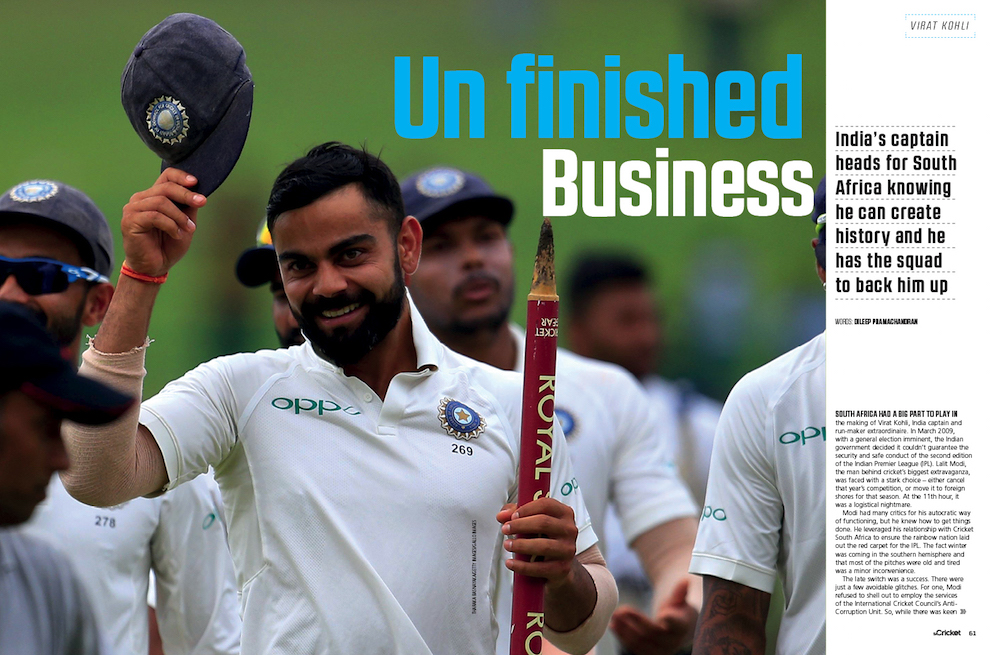South Africa had a big part to play in the making of Virat Kohli, writes DILEEP PREMACHANDRAN.
South Africa had a big part to play in the making of Virat Kohli, India captain and run-maker extraordinaire. In March 2009, with a general election imminent, the Indian government decided it couldn’t guarantee the security and safe conduct of the second edition of the Indian Premier League (IPL). Lalit Modi, the man behind cricket’s biggest extravaganza, was faced with a stark choice – either cancel that year’s competition or move it to foreign shores for that season. At the 11th hour, it was a logistical nightmare.
Modi had many critics for his autocratic way of functioning, but he knew how to get things done. He leveraged his relationship with Cricket South Africa to ensure the rainbow nation laid out the red carpet for the IPL. The fact winter was coming in the southern hemisphere and that most of the pitches were old and tired was a minor inconvenience.
The late switch was a success. There were just a few avoidable glitches. For one, Modi refused to shell out to employ the services of the International Cricket Council’s Anti-Corruption Unit. So, while there was keen competition on the field, it was pretty much a free-for-all off it.
Every lowlife in the cricket universe made their way to South Africa. They’d be found in poorly lit corners of most nightclubs, often in leather jackets, sporting heavy watches and even heavier gold chains. They’d usually have a posse of young players with them. Most of these boys, who had grown up in sheltered surroundings where dating was unheard of, behaved like kids in a candy store. The undesirables, aside from promising them this deal and that, doubled up as pimps.
It wasn’t as though it was the first time they had targeted these players, either. When India beat South Africa to win the U19 World Cup in Malaysia in 2008, many of these men were in attendance, promising a shoe deal here and a bat contract there. Oakleys and other goodies were gifted and the kids swanned around, unaware of how they were leaving themselves exposed to future favours.
With several of the Indian U19 stars having earned contracts worth 3-million rupees (around R650,000) for the first IPL, too much too soon was a real worry, with Indian cricket’s great and good debating mentoring programmes and other initiatives that never saw the light of day. Those were worrying times.
Kohli had been signed up by Royal Challengers Bangalore (RCB). Their first season had been a shamble and by the end of it Vijay Mallya, the erstwhile team owner who now faces extradition from the UK for financial irregularities, was publicly slating Rahul Dravid’s captaincy. By season two, Anil Kumble had replaced him and there was a new face as coach too – Ray Jennings.
An IPL in South Africa suited Jennings perfectly. One of his biggest challenges, however, was to make sure the younger group maintained focus in a scenario where they were being exposed to all manner of temptations. One evening in Durban, midway through the tournament, we caught up at a bar to chat about his new assignment.
His views on the young ’uns were especially instructive. This, after all, was a man who had said he would make his players drink tap water when he coached South Africa. But tough love alone wouldn’t work, Jennings told me. You had to give them a sense of perspective. ‘I tell the boys that no one will give a f*** in a couple of years’ time what they did as U19s,’ he said. ‘It’s what you do from here on that matters.’
At the time, Manish Pandey, who made the first IPL century by an Indian, at Centurion, was considered the one most likely to become a regular in the senior side. Kohli, who had made his debut for the national team on a tour of Sri Lanka six months earlier, was considered high maintenance and a bit of a party boy.
Jennings and Kumble were big influences at the time, not hesitating to lay down the law, but the seniors in the Indian dressing room were just as important. From one of them, his hero, Kohli had seen how ephemeral fame could be, and how vital a sense of balance was. Sachin Tendulkar and his India teammates were in South Africa, and on the verge of clinching India’s first Test win there, at the Wanderers in December 2006, when most in the cricket fraternity first heard Kohli’s name.
Just weeks after he turned 18, he lost his father, Prem, midway through a Ranji Trophy game. To general astonishment, he was at the Feroz Shah Kotla the next morning, to resume batting on 40. He went on to make 90 before going home to attend the funeral. Even with the success at The Wanderers and the volatile dressing-room environment under Greg Chappell, people sat up and took notice of the teenager his teammates called ‘Cheeku’.
That South African tour didn’t end well for India, as Graeme Smith’s side stormed back to win in Durban and Cape Town. At Newlands, India held most of the aces, but a mystifyingly negative passage of batting from Tendulkar and Dravid, the team’s gun batsmen, gave South Africa the initiative. When the squad returned home, the criticism was harsh. Even Tendulkar, holiest of cows, wasn’t exempt from it.
But instead of going into hiding, Tendulkar decided to help out an old friend, Lalchand Rajput, one-time Mumbai teammate who coached the U19s. The squad was about to leave for New Zealand and Rajput asked Tendulkar to speak to them. It was the first time Kohli had met his idol in the flesh. He told me later that he had goosebumps – it was nearly 30ºC. ‘I didn’t even blink my eyes because I couldn’t quite believe it,’ he said.
From Tendulkar, Dravid, VVS Laxman and others, Kohli quickly learned there was no elevator you could take to bypass the rungs on the ladder of success. The first couple of years after his father’s passing saw him in a bit of a funk – despite the attention gained by the U19 victory – and it took him time to figure out his priorities. Once he did, everyone noticed.
‘I can never get him out of the nets,’ said Jennings, not long after RCB had made Kohli their captain. ‘It’s scary how much success he wants. It’s almost like he doesn’t want others to succeed. That’s an amazing quality. He wants to be the best. Those are aspects that can be looked at as faults by others, but are strengths that will make him a top cricketer. ‘He’s not your typical Indian player. The aggression is very Australian or South African.’
As Kohli’s career progressed, that became something of a common refrain. On India’s disastrous tour of Australia in 2011-12, when they were blanked 4-0, he was the only one to make a century. On his next visit there, he made four in four Tests, including two in the Adelaide match that followed the tragic passing of Phillip Hughes.
‘Kohli is the kind of cricketer Australians would love to call their own,’ Alex Brown, then managing editor of Fox Sports News, told me. ‘He can turn a game single-handedly. He talks back. He fears no one. Many cricketers wither when confronted by a hostile Australian team and audience. Kohli appears to thrive on it.’
He remains as animated as ever on the field, as witnessed during the crisis that followed last March’s Bangalore Test when he all but accused Steve Smith of cheating. But away from the cares of leading India in all three formats, he has developed a keen interest in several issues of the day, using his social media handles to talk about women’s rights, kindness to pets, Delhi’s pollution problem and much else.
Of course, the most followed Instagram posts are the selfies, workout videos and candid moments with his teammates. It’s also there that he gushes most about the South African he refers to as his ‘brother from another mother’. ‘Very few people in my life have connected with me like my dear friend AB [de Villiers] and I share the most wonderful bond with this great man,’ says one post. ‘So much to learn from him all the time. If you ever want a role model for any walk of life, he is IT. @abdevilliers17. #topman #greathuman’.
That admiration will be tested in early 2018, as De Villiers returns to South Africa’s Test ranks to try to thwart India’s bid to win a first series in the republic. The two batsmen the great Sir Viv Richards says remind him most of himself on opposite sides of the divide, instead of being comrades in Bangalore’s red, black and gold.
The last time, in 2013, Kohli started the series at The Wanderers with two sensational innings (119 and 96) to put India in control, but De Villiers, with Faf du Plessis for company, so nearly scaled a 458-run mountain. By the end, India were hanging on for the draw.
Under Kohli’s leadership, this is a very different, and better equipped, Indian side. Though he insists he isn’t guided by the history books, he’s well aware that cricketing immortality awaits the first Indian captain to win in South Africa and Australia. More than 11 years after the tragedy that thrust him unwittingly into the limelight, Kohli is ready for the challenge.
In a Father’s Day Instagram post dedicated to the friend-philosopher-guide he lost, he uses the hashtag ‘pillarsofstrength’. For Indian cricket, that’s what the boy-who-was-trouble has become. He’ll only get stronger.
– This article first appeared in the January-March 2018 issue of SA Cricket magazine, on sale now.







